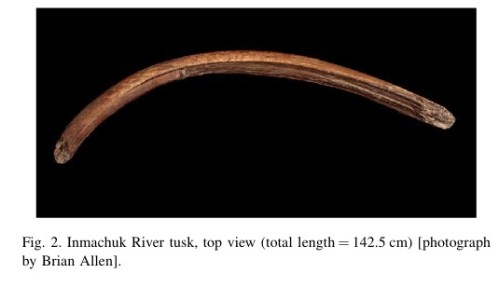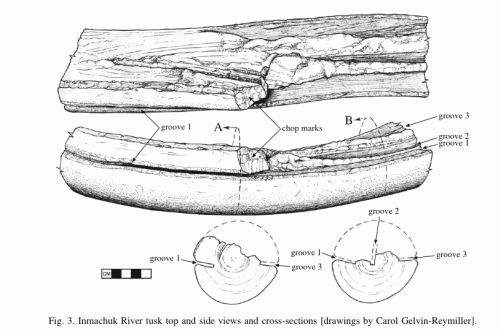
Worked 35,000 year old mammoth tusk from Alaska. Note scale! Source: Gelvin-Reymuller et al.
This is getting a little out of the area, but I’ve just run across a report by Gelvin-Reymuller et al. (download PDF) on the finding of a worked mammoth tusk from the north side of the Seward Peninsula. That is on the west-central Alaska coast near the closest approach to Asia, and hence smack in the middle of Beringia. The tusk is interesting in its own right, of course, but doubly so when we see that it was dated to well before the last glacial maximum:
Though the age of the tusk is only peripherally relevant to the significance of the reduction described in this paper, the tusk was sampled for dating. A single bone collagen sample from the tusk was dated by Beta Analytic, Inc. following standard pretreatment and analytical procedures. A 5.2 g of sample was first removed from an inner area, well beneath a surficial treatment of Elmer’s Glue-All which the tusk’s discoverer had initially applied to the surface. The resultant AMS date was 35,150 +/- 530 BP (Beta-189092). …… The latest mammoth remains in mainland Alaska are dated to around 11,400 BP. Since the age of this tusk places it beyond the range of initial human habitation in the New World, as currently understood, we posit that the tusk was worked by later inhabitants of the area.
The authors note that it is possible to diagnose from the reduction strategies used whether ivory was worked when fresh/green or when already subfossilized, though curiously they draw no such conclusions about this particular piece. I find it intriguing how a central Beringian artifact made on a 35,000 year old material is so readily characterized as a recent manufacture. While this piece would pre-date the earliest known record of extreme NE Asia and while I wouldn’t second-guess the authors nor impugn their motives and while it is certainly possible that a fossil mammoth tusk was worked at a much later date, I’m, uh, just sayin’. This paper is interesting on a number of levels, not least as an example of stickhandling around competing paradigms.

Detail of working method of Alaskan tusk. Source: Gelvin-Reymuller et al




